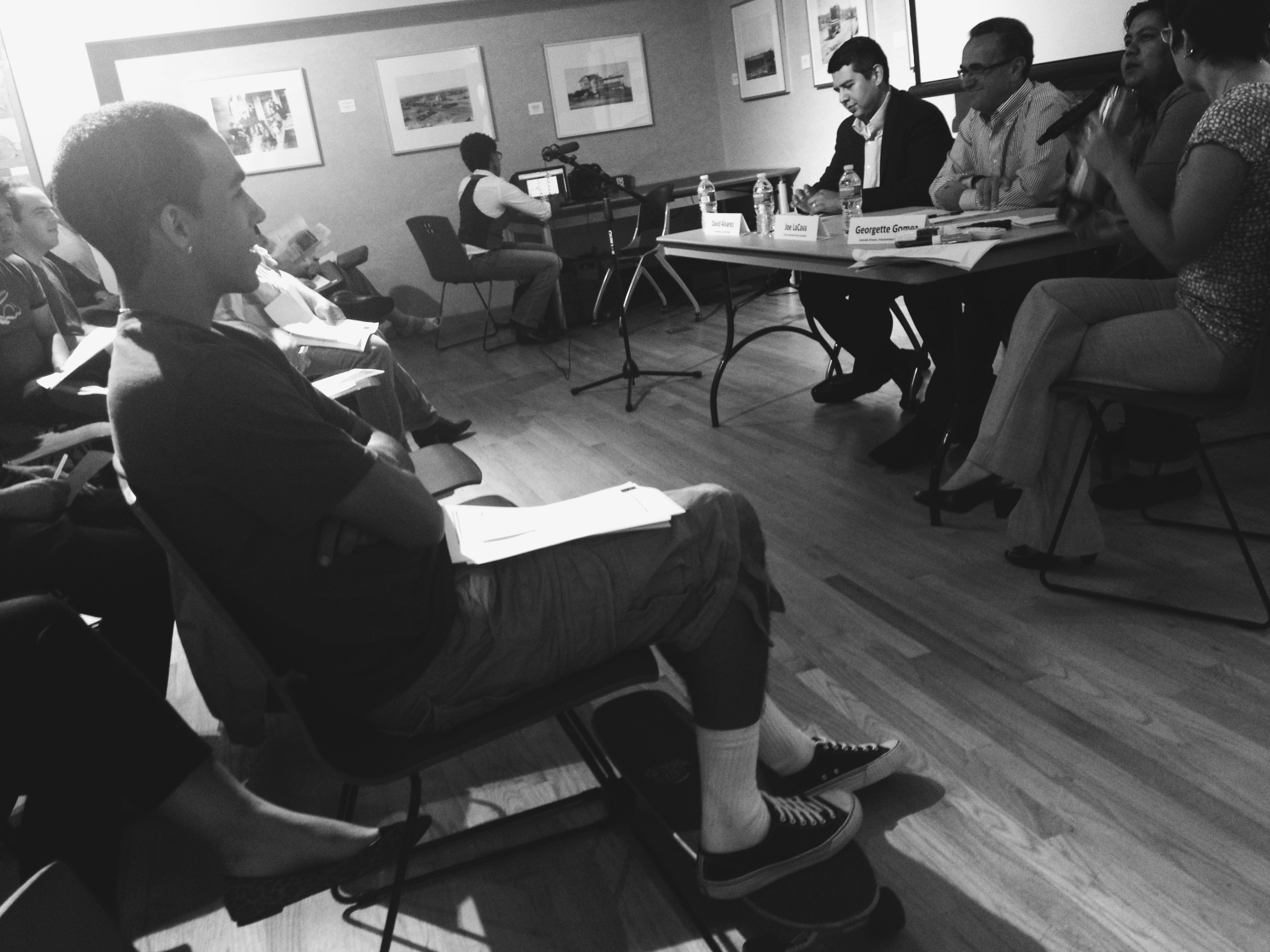 Ryan Jackson, 19, took two buses and his skateboard to a community planning training hosted by the Community Budget Alliance. He says he wanted to find out how to bring more transportation options to his Skyline Hills neighborhood. | Photo Credit: Megan Burks
Ryan Jackson, 19, took two buses and his skateboard to a community planning training hosted by the Community Budget Alliance. He says he wanted to find out how to bring more transportation options to his Skyline Hills neighborhood. | Photo Credit: Megan Burks
By Megan Burks
The new fiscal year started about a month ago, but already the city is gearing up to determine which projects make it into next year’s budget.
Local community groups are a step ahead; residents are mobilizing to make their voices heard before the city takes its first swing at a budget draft.
About 50 people spent Wednesday night at the Logan Heights Library talking about zoning and throwing around acronyms like CIPRAC (Capital Improvements Program Review and Advisory Committee) and CIP (Capital Improvements Program). But the mood was surprisingly light and energetic.
That’s because, in addition to officials who are accustomed to all that jargon, there were moms from the neighborhood and teens who skateboarded to the meeting.
It was one in a series of trainings the Community Budget Alliance and Center for Policy Initiatives is doing to demystify the budget process and bring new faces into the conversation.
Ryan Jackson, 19, sat in the front row wearing Converse sneakers and stud earrings. He says the meeting was his first introduction to community planning.
“I can say I’ve always been a bit of a nerd. I like maps and stuff,” Jackson said. “I don’t know, for some reason I just started to have a fondness and interest in my community, wanting to make it better for the people after me, especially my little sister.”
Jackson said he’d like to see more transit options and jobs in his neighborhood, Skyline Hills.
Organizer Corinne Wilson said similar trainings during the last budget cycle resulted in some major wins for San Diego’s neighborhoods. One budget hearing had more than 200 public speakers, many groomed by the budget alliance. Their comments helped push through 11 new projects, including a skate plaza in City Heights and a pilot program that will provide free bus passes to some San Diego Unified students.
At the Wednesday meeting, Wilson offered five ways residents can ensure similar attention is paid to their communities in the future.
Send a text.
CBA and CPI have teamed up with Code for America (which Wilson describes as Teach for America for computer geeks) to develop a mobile phone app that sends budget recommendations directly to area planning groups and CIPRAC, which helps craft the mayor’s first budget draft each October and November. Just text “rebuild” to (619) 326-9125 and answer a series of questions about what you’d like to see in your community. You can fill out the same survey online here.
Attend community planning group meetings.
Wilson and panelists Councilman David Alvarez, the Environmental Health Coalition‘s Georgette Gomez and Community Planners Committee Chair Joe LaCava urged attendees to participate in their community planning groups. The groups meet monthly throughout the city and help advise the city on land-use decisions. Alvarez said the meetings “are the first place you’re going to find out about something that’s going on that you may or may not like.”
Participate in community plan updates.
Community plans dictate how a neighborhood, or a collection of neighborhoods, should grow. Through it, community members decide where homes should go, where industry and business should go and what public facilities are needed. The plans tell the planning group and the city which developments they can approve (or at least make it harder for them to approve projects the community hasn’t said it wants yet).
The plan updates don’t happen very often, but many are due for a rewrite and new Planning Director Bill Fulton has made them his first priority. He said Barrio Logan’s new plan will go to the City Council for approval Sept. 17. The Otay Mesa and San Ysidro plans will enter the environmental review process in the coming weeks, Fulton said. And city planners are working with residents to write first drafts for Uptown, greater North Park, greater Golden Hill, southeastern San Diego and Encanto.
Tell the city how to spend its bond money.
The city is expected to issue an $80 to $100-million bond next year for infrastructure. Wilson said half would be spent on roads and deteriorating pipes, but the other half is up for grabs – or can at least be lobbied for. Council members have already been working on a list of projects to spend the money on, which brings us to Wilson’s main takeaway.
Be a squeaky wheel.
Wilson advised attendees to call their council members frequently so their ideas get in on the ground floor, before a representative is called to make recommendations to the city. As she put it, the squeaky wheel gets the grease.
